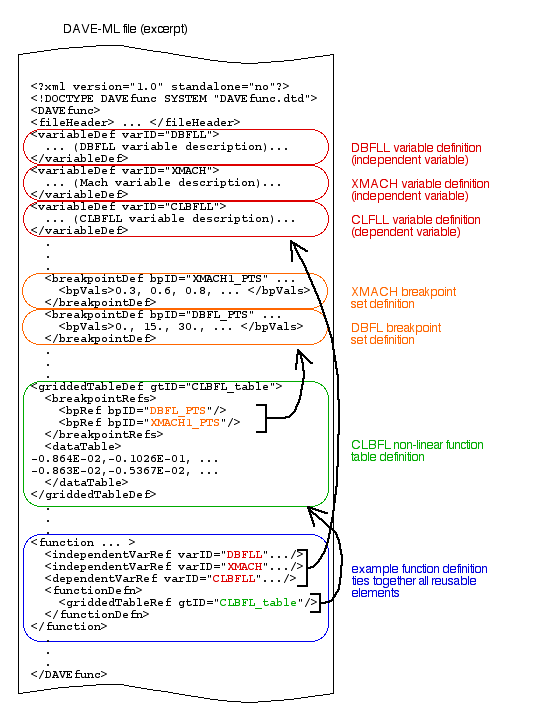The DAVEfunc element contains both data
tables and equations for a particular vehicle subsystem model, for example, the aerodynamic
model or the mass/inertia model. A DAVEfunc element is broken into
roughly five components: a file header, variable definitions, breakpoint definitions, table
definitions, and function definitions. This decomposition reflects common practice in
engineering development flight simulation models in which the aerodynamic database is
usually captured in multidimensional, linearly interpolated function tables. The input to
these tables are usually state variables of the simulation (such as Mach number or
angle-of-attack). The outputs from these interpolated tables are combined to represent
forces and moments acting on the vehicle due to aerodynamics.
It is possible, using DAVEfunc and MathML elements, to completely define an aerodynamic model without use of function tables (by mathematical combinations of input variables, such as a polynomial model) but this is not yet common in the American flight simulation industry.
A fileHeader element is
included to give background and reference data for the represented model.
Variables, or more properly signals, are used to route inputs,
calculations and outputs through the subsystem model. Each variable is defined with a variableDef element. Variables can
be thought of as parameters in a computer program, or signal paths on a block diagram. They
can be inputs to the subsystem model, constant values, outputs of the model, and/or the
results of intermediate calculations. Variables must be defined for each input and output
for any function elements as well as any input or output of the subsystem represented.
MathML content markup can
be used to define constant, intermediate, or output variables as mathematical combination of
constant values, function table outputs, and other variables. MathML
presentation markup can also be used to define the symbol to use in
documentation for each defined variable. Variables also represent the current value of a
function (the dependentVariableDef in a function definition) so the output of
functions can be used as inputs to other variables or functions.
Breakpoint definitions, captured in
breakpointDef elements, consist of a list of
monotonically-increasing floating-point values separated by commas. These sets are referenced
by "gridded" function table definitions and may be referenced by more than one function definition.
Function table definitions, described by
griddedTableDef and ungriddedTableDef elements,
generally contain the bulk of data points in an aero model, and typically represent a smooth
hyper-surface representing the value of some aerodynamic non-dimensional coefficient as a
function of one or more vehicle states (typically Mach number, angle of attack, control
surface deflection, and/or angular body rates). These function tables can be either
"gridded," meaning the function has a value at every intersection of each dimension's
breakpoint, or "ungridded," meaning each data point has a specified coordinate location in
n-space. The same table can be reused in several functions, such as a left- and right-aileron
moment contribution.
Function definitions (described by function elements) connect breakpoint
sets and data tables to define how an output signal (or dependent variable) should vary with
one or more input signals (or independent variables). The valid ranges of input signal
magnitudes, along with extrapolation requirements for out-of-range inputs, can be
defined. There is no limit to the number of independent variables, or function
dimensionality, of the function.
Check case data (described by checkData elements) can be included to
provide information to automatically verify the proper implementation of the model by the
recipient. Multiple check cases can (and should) be specified, as well as optional internal signal values
within the model to assist in debugging an instantiation of the model by the recipient.
Figure 1 contains excerpts from an example model, showing the major parts of a DAVE-ML file.
A simpler version of a function is
available in which the dependent variable breakpoint values and dependent output values are
specified directly inside the function
body. This may be preferred for models that do not reuse function or breakpoint data.
A third form of function is to give the
gridded table values or ungridded table values inside the function body, but refer to externally
defined breakpoint sets. This allows reuse of the breakpoint sets by other
functions, but keeps the table data private.
